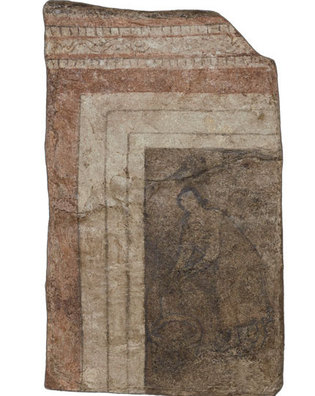 loading
loading
Arts & CultureBirth announcement?Object lesson: An ancient image may depict Mary, the mother of Jesus. Michael Peppard ’03MAR, ’09PhD, is an associate professor of theology at Fordham University.  Yale University Art GalleryThis faded wall painting, an image from a third-century Christian church in what is now Syria, shows a woman at a well. But who is she? View full imageQuick Bible quiz: when Mary, the mother of Jesus, was greeted by the angel Gabriel and told of her miraculous pregnancy, where was she? If you said “at home,” you’re in good company.Almost all Christians in the United States and Europe would answer that way. It’s not technically wrong—but it’s not right either. The canonical version of this event, described in the Christian Bible and known as the Annunciation, does not specify a location. So why did you think you knew? Most people have formed their sense of the settings of biblical episodes by having seen them depicted in the history of Western art. The Annunciation is one of the most frequently painted biblical scenes, and most versions place Mary in her home. Just like when we read a book and then see its movie version, a biblical story’s visual depiction is almost impossible to dislodge from our minds, even if we know the textual version well. But if we were to give this same quiz to ancient Christians (or modern ones in other parts of the world), many respondents would offer a different answer. According to the Protevangelium of James, a noncanonical but influential second-century biography of Mary’s early life, the angel first approached Mary outside, while she was doing the daily work of drawing water from a well or spring. For centuries, Holy Land pilgrims have visited “Mary’s Well” in Nazareth. This scene had an artistic trajectory too, being depicted on sarcophagi, ivory book covers, illuminated manuscripts, and church walls from places such as Turkey, Syria, Armenia, and Serbia. A painting that may represent this Annunciation at the Well is on display at the Yale University Art Gallery. Most scholars have taken it for a different well scene, but if I’ve identified it correctly, it is the oldest Annunciation at the Well yet discovered. As I explain in my book The World’s Oldest Church (Yale University Press, 2016), this painting came from Dura-Europos, an ancient city in eastern Syria that was excavated by Yale archaeologists in the 1920s and 1930s. Among the many finds exhibited in the gallery—including an intact Roman shield, horse armor (see Object Lesson, July/August 2014), and a sacrificial altar—are the remains of a third-century house that was used as a Christian church. The paintings on its walls are the only church wall art to survive from before the conversion of Emperor Constantine in the fourth century. The southern wall of the building’s baptistery displayed this painting of a woman bent over a well. Holding the rope of her vessel, she looks out at the viewer, or perhaps over her shoulder, seemingly startled in the act of drawing water. Though almost all scholars have considered her to be the Samaritan Woman at the Well—a character in the Gospel of John who has a dialogue with Jesus—the figure does not resemble other images of the Samaritan Woman. It does, however, bear formal resemblance to later versions of the Annunciation at the Well. Moreover, an archived sketch done by the archaeologists on site in 1932 shows details no longer visible on the faded painting: two lines touching the woman’s back and a kind of starburst on the front of her torso. Both features were described as “unexplained” in the archaeological report. But with the new interpretation of the figure, the lines, which are similar to those in later Eastern iconography, invite a rather evident meaning. They represent a motion toward the woman’s body and a spark of activity within it, as if something invisible were approaching and entering her: an incarnation. This new interpretation is under review by the gallery’s curators and will also receive scrutiny by other scholars. In the meantime, it has drawn more visitors to the Dura-Europos collection. It may even cause some to dust off their Bibles, to find out what else they thought they knew.
The comment period has expired.
|
|